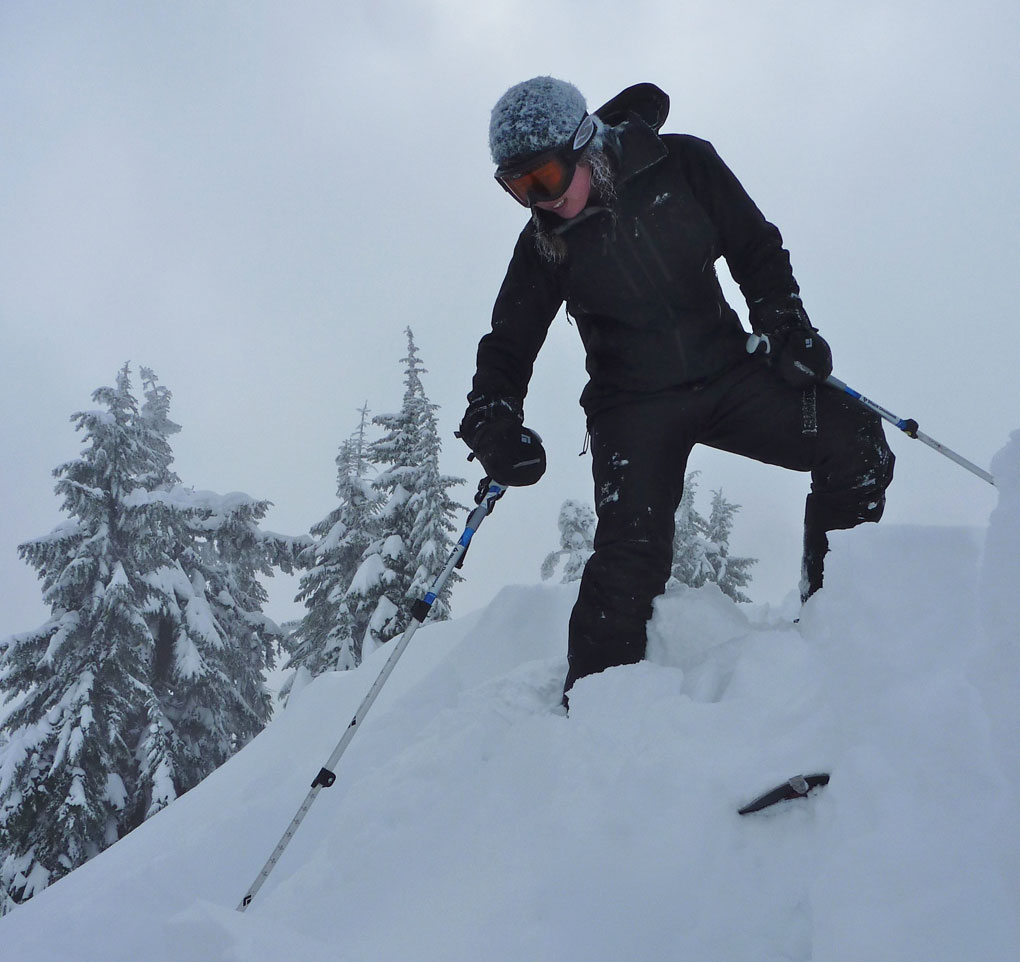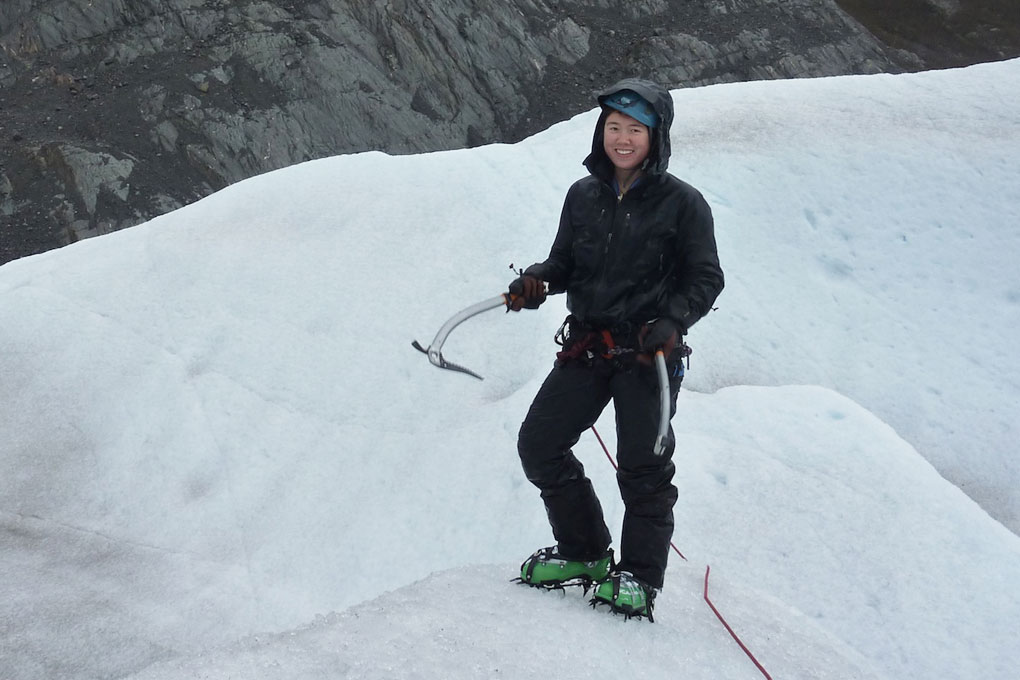Waterproofing
Those of us who spend time in the PNW understand the necessity of a good rain jacket. Having grown up in a town that receives an average of 220 days of precipitation per year, and going to school where it rains 100 inches annually, I have learned that playing in the rain is the only way to stay sane. From warm, wet, muddy hikes to slush-filled skinning missions, the Triolet has fulfilled all of my expectations of a waterproof-breathable shell.

The DWR finish on this jacket has been exceptional and performed beyond expectation. The hood, stomach, and forearms all still bead water after more than two years of abuse. The rest of the jacket no longer beads water, but the fabric does not leak in the seams or ooze through the membrane in any location. And since it’s still keeping water out, I have not once washed or dried the Triolet. (By comparison, I washed, treated, and dried my previous Arc’teryx AR shell two or three times in the 18 months I used it without noticing lasting improvements.)
Patagonia describes the zippers on the Triolet as being low bulk, watertight, and coated. As is almost always the case with such zippers, they can require more effort to unzip. I can only undo my pit zips with one gloved hand when I grab both the cuff of my sleeve and the base of the jacket. But after 200 days of use, they also seem more durable than the zippers on my Arc’teryx AR shell or Gregory backpack. The coating has not delaminated to any extent or shown any wear, as they have on my Arc’teryx AR and Gregory pack, where the zippers shed thin strips of their coating throughout the time I’ve used them (two years and six months, respectively).
The seams are sealed with a fabric laminate that has proved itself thus far; I have had absolutely no leaks.
Warmth
During moderate activity levels and cool temperatures (5-25 degrees F / -15 to -4 C), the Triolet shell is warm enough that just a baselayer underneath keeps me comfortable. And if I need to, like when continuously skinning, I can keep the pit zips open to prevent excess heat from building up inside the jacket.
When I stop moving, however, I throw my Patagonia DAS parka on over everything. Not only is this more convenient, it’s also warmer. (As I mentioned earlier, when worn underneath, the sleeves of the Triolet, even in size large, are too skinny to accommodate the bulk of my high-loft DAS parka.)
If temperatures are warmer (closer to freezing), I’ll instead throw on a midlayer fleece under the Triolet for the decent.
But again, for most activities up to freezing, or light activity up to about 40 degrees (5 degrees C), I find it sufficient to wear just a baselayer underneath the Triolet.
Breathability / Ventilation
I have generally been happy with the Triolet’s ventilation and breathability. I tend to heat up very quickly (I’m sweating within five minutes of moving unless it’s below 20 degrees F / -6 degrees C outside), and have mostly stayed dry with the pit zips fully opened so long as I’m not profusely sweating—let’s face it, no waterproof / breathable shell is truly breathable enough to allow drenching sweat to evaporate.
So the pit zips are crucial for me, and I love the fact that these extend from my elbow to my waist. Not only does this allow me to dump heat quickly, but in times of serious overheating, I can pull my elbows and forearms out of the jacket through the pit zips, then tuck the empty arms through an arm strap of my backpack. This effectively converts my technical shell into a vest, dumping heat even faster.
The only times I have run into moisture issues inside of this shell have been warm (40+ degrees F / 5+ degrees C) and wet trips, adventures when I am futilely attempting to stay under cover from the rain and wet bushes but overheating in the process. But this is largely a combination of high water concentration outside and very high moisture inside, as opposed to a lack of water repellency on the exterior or breathability.
Durability / Materials
After running into countless conifer branches, swinging skis over my shoulder, and rubbing up against sharp rocks and ice, the Triolet has pushed through without a scratch.
The first—and single greatest—impression I had of this jacket was how tough and thick the fabric felt. The fabric is rougher and tougher (5.5 oz 70-denier nylon) on the shoulders, forearms, and chest than on the middle of the back or underneath the arms (4.2 oz 40-denier nylon). Additional material creates a slightly heavier jacket (1 pound, 3 ounces) than comparable Arc’teryx jackets, but only by 3-5 ounces.
Personally, I am thankful for the robust nylon outer layer whenever my heavy backpack is moving over my shoulders and back, or when I’m ‘shwacking through early season alder trees and rough conifers. These high-wear areas have held up great.
Packability
I would place the Triolet in the realm of moderate weight and packability of technical shells. The use of 70-denier nylon makes it exceptionally durable but not as lightweight or packable (obviously) as shells made of thinner, lighter materials.
When I roll the Triolet into its own hood, it is roughly the height of a Nalgene water bottle, and the width of one and a half Nalgenes. (I also like the system of rolling it into its hood because I believe it preserves the shape of the visor and avoids mass-wrinkling of the jacket.)
Bottom Line
The Patagonia Triolet jacket was designed to protect the serious outdoor enthusiast from cold, wet, and severe weather in the alpine, and after two years of heavy use in the Pacific Northwest, I have been exceptionally pleased with its performance.
The only changes I personally would like to see are a wider sleeve and a third direction of cinching to the hood. (And keep in mind that the sleeve width may be less of an issue for you.)
If you spend your time exploring dry interior snow for day trips, this may be a heavier and tougher shell than you’ll need. But I definitely recommend this jacket to anyone who is ski touring / mountaineering / ice-climbing in cold and wet climates.


Thank you for your review.
Curious to hear about how little you have washed treated your jackets. what is the longest a jacket has lasted for you? have you had success treating any? It seems that frequent washing is becoming more the recommendation, with treatment once it stops beading water. I am glad to hear the triolet is still waterproof for you though no longer beading up.
another question, what jacket do you turn to on 50 and 60 degree days for waterproof rain protection?
~nicholas
Thanks for your inquiry, Nicholas! During the lifetime of this Triolet jacket I think I only washed and dried it twice, each time with GoreTex soap. I have also heard we are moving towards cleaning our shells more frequently, but I have to admit I’ve actually become a little cynical about how we can stay dry while exercising in a shell in warm and wet conditions. I’m definitely a proponent of pulling my arms through the pit zips to vent. I also have started to use an umbrella. Or, when it’s 50-60 and raining, I literally don’t wear a rain jacket – I leave it dry in my pack and save it for when I stop moving, and I keep a dry layer in a dry bag in my pack. Sorry I don’t have a silver bullet!
Thank You Iris, as I read more into the world of rain jackets I am needing to reassess and determine which uses I need a rain jacket for (Finally replacing my de-laminated 2.5 layer shell). Here in the northwest there is a lot of cool weather with rain. Temperatures I don’t really want to get wet in. But in other places, where a quick shower might come through, getting wet can be ok – or having an alpine houdini that will block the brunt of a storm for a time but eventually soaks through.
What I am recalling from my experience is that my extremities get cold and take forever to warm up, especially if they get damp or wet. That makes changing layers and setting up camp to become dry difficult…
more reading and thinking for me! Happy Adventures!